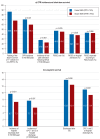The Effect of Ambulance Response Time on Survival Following Out-of-Hospital Cardiac Arrest
- PMID: 30189973
- PMCID: PMC6156551
- DOI: 10.3238/arztebl.2018.0541
The Effect of Ambulance Response Time on Survival Following Out-of-Hospital Cardiac Arrest
Abstract
Background: Out of hospital cardiac arrest (OHCA) is one of the more common causes of death in Germany. Ambulance response time is an important planning parameter for emergency medical services (EMS) systems. We studied the effect of ambulance response time on survival after resuscitation from OHCA.
Methods: We analyzed data from the German Resuscitation Registry for the years 2010-2016. First, we used a multivariate logistic regression analysis to determine the effect of ambulance response time (defined as the interval from the alarm to the arrival of the first rescue vehicle) on the hospital-discharge rate (in percent), depending on various factors, including resuscitation by bystanders. Second, we compared faster and slower EMS systems (defined as those arriving on the scene within 8 minutes in more than 75% of cases or in ≤ 75% of cases) with respect to the frequency of resuscitation and the number of surviving patients.
Results: Our analysis of data from a total of 10 853 patients in the logistical regression model revealed that the rate of hospital discharge was significantly affected by the ambulance response time, bystander resuscitation, past medical history, age, witnessed vs. unwitnessed collapse, the initial heart rhythm, and the site of the collapse. The success of resuscitation was inversely related to the ambulance response time; thus, among patients who did not receive bystander resuscitation, the discharge rate declined from 12.9% at a mean response time of 1 minute and 10 seconds to 6.4% at a mean response time of 9 minutes and 47 seconds. Twelve faster EMS systems and 13 slower ones were identified, with a total of 9669 and 7865 resuscitated patients, respectively. The faster EMS systems initiated resuscitation more frequently and also had a higher discharge rate with good neurological outcome in proportion to the population of the catchment area (7.7 versus 5.6 persons per 100 000 population per year, odds ratio [OR] 0.72, 95% confidence interval [0.66; 0.79], p<0.001).
Conclusion: Rapid ambulance response is associated with a higher rate of survival from OHCA with good neurological outcome. The response time, independently of whether bystander resuscitation measures are provided, ha^ a significant independent effect on the survival rate. In drawing conclusions from these findings, one should bear in mind that this was a retrospective registry study, with the corresponding limitations.
Figures




References
-
- Gräsner JT, Lefering R, Koster RW, et al. EuReCa ONE-27 Nations, ONE Europe, ONE Registry: a prospective one month analysis of out-of-hospital cardiac arrest outcomes in 27 countries in Europe. Resuscitation. 2016;105:188–195. - PubMed
-
- Berdowski J, Berg RA, Tijssen JGP, Koster RW. Global incidences of out-of-hospital cardiac arrest and survival rates: systematic review of 67 prospective studies. Resuscitation. 2010;81:1479–1487. - PubMed
-
- Nürnberger A, Sterz F, Malzer R, et al. Out of hospital cardiac arrest in Vienna: incidence and outcome. Resuscitation. 2013;84:42–47. - PubMed
-
- Atwood C, Eisenberg MS, Herlitz J, Rea TD. incidence of EMS-treated out-of-hospital cardiac arrest in Europe. Resuscitation. 2005;67:75–80. - PubMed
MeSH terms
LinkOut - more resources
Full Text Sources
Other Literature Sources
Miscellaneous

